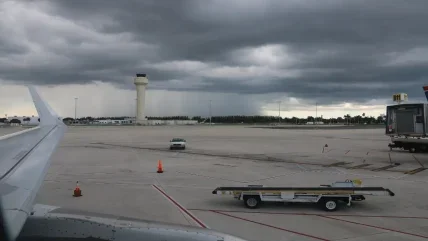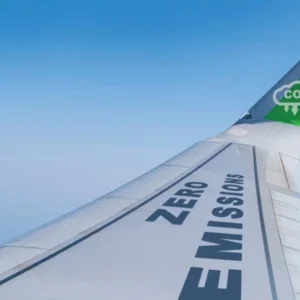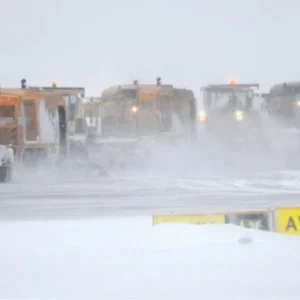
In the summer of 2022, the UK’s Luton Airport made global headlines when its runway ‘melted’ during a heatwave that saw temperatures across Europe break all-time records. The asphalt on the runway began to soften and peel up, causing flights to be cancelled. However, this was not the first instance of extreme weather taking its toll on airport infrastructure, and scientists warn it certainly won’t be the last. From flooding and wildfires to high winds and soaring temperatures, climate change poses a number of challenging conditions for airports, whose efforts to adapt to them are more urgent than ever.
According to a 2019 report by ACI World, almost 70% of airport operators said they had already felt the impact of intensifying weather patterns. “Civil-engineering structures, whether these are buildings, runways or taxiways, are all designed for a finite life, which may be anywhere from 20 to 100 years,” says Amit Bhasin, the professor and director of the Centre for Transportation Research at the University of Texas, Austin. “The challenge that we face is that the environmental conditions used for design are based on historical weather records. So, if the future weather patterns become very different and more extreme compared with the past, our design assumptions are no longer valid – and in some cases, this would mean our structures may fail completely.”
Running hot and cold
Indeed, European airports were not prepared for the temperatures they faced in the summer of 2022 – and similarly, countries that typically don’t experience freezing temperatures, such as Kuwait, are seeing winter storms leaving ice and snow on runways that were not built to manage it. In places such as the UK and Australia, asphalt runways with a lifespan of 10–15 years are most common, but they use varying stiffness levels depending on their environment, according to Greg White, the director of the Airport Pavement Research Program at Queensland’s University of the Sunshine Coast. Consequently, in Australia, where summer temperatures of 40ºC are likely, runways do not melt the way they did at Luton when the UK surpassed 37ºC.
“You can engineer the asphalt on the surface of most runways to cater to any climatic requirement – but you can’t make it cover all climatic requirements,” White says, explaining that the formulation in Australia also wouldn’t work in the UK because it would place runways at risk during cold spells. “If temperatures reach 25ºC or even 30ºC, the pavement temperature could reach 50ºC. Asphalt has a softening point of around 50–55ºC, because of a property in the bitumen, so that means it would be past its softening point. You can sometimes see that in roads: if you push the surface on a hot sunny day, you’ll be able to move the stones around. But then if you come back on a cool morning and you try and push it, you can’t – because it has become solid again.”
So, if an airport runway were to reach its softened state, the heavy loads it usually accommodates – including planes, fire tankers and refuelling trucks – would cause the surface to become uneven once cooled down. In colder climates such as Canada, warmer temperatures are an issue for a different reason: Canada used to be in the permafrost zone, and is now experiencing freeze-thaw cycles, whereby the runways defrost in the summer and re-freeze in the winter. “As a result, you end up with big lumps in your runway where things have moved around during that process,” says White.
One way to respond to extremely hot and cold conditions is by using a surface with added polymers that accommodate a wider range of temperatures. “It makes it more expensive, but it will broaden the coldest to the hottest that it would be happy to live in,” explains White; but it is a large undertaking to replace a runway surface. “It typically takes four to eight weeks of work every night to slowly move from one end of the runway to the other.”
Ensuring safety
This could be delayed further as changing weather means runways need to be extended, too. A 2021 Federal Aviation Administration study showed runways at some of the US’s busiest airports may need to be lengthened by at least 500ft as planes require longer take-off distances in hot air (which is thinner than cold) and higher rainfall requires further braking distance. A Climate Change Risks for European Aviation study, conducted by Eurocontrol in 2021, found that flooding from sea-level rise at airports in Europe is also increasingly probable. Two-thirds of coastal or low-lying airports are projected to be at risk of flooding from storm surges by 2090 and face a swell in temporary flooding from heavy, prolonged rainfall. “Runways are very flat, so for airports built only a little bit above the sea level, there’s potential for them to end up underwater,” says White. “If sea-levels rise, they will either need to build the runway up further or find a new runway on higher ground.”
The likelihood of such conditions causing an aircraft to crash and people being injured is low due to the many safeguards in place. “But what it does do, in a practical way, is it forces the airport to close the runway until [the problem is] fixed, and that disrupts flights,” says White.
Rachel Burbidge, the senior policy officer of environment and climate change at Eurocontrol, concurs. “For passengers, I think the safety risks are minimal – operations would be halted if conditions were unsafe,” she says. “Passengers are more likely to experience frustrations due to impacts to their journey such as delayed, cancelled or even diverted flights.” As stated in a 2020 study by McKinsey, if improvements aren’t made imminently, by 2050 the number of passengers impacted by airport delays will be 23 times higher.
70%
The estimated percentage of airport operators that said they had already felt the impact of intensifying weather patterns.
ACI World
$2.6m
The cost of a one-day airport closure due to flooding for a medium-sized airport (30,000–100,000 flights per year). The cost is £15.7m for large airports.
Eurocontrol
White notes that the difficulty is in predicting if and when measures like these will be needed, but Burbidge stresses the necessity to err on the side of caution. “It’s really important that measures are timely and proportionate. It is essential for individual airports to carry out a climate-change risk assessment and then identify and implement appropriate adaptation responses.” While all EU countries have developed national plans for how they will cope with climate change, they are often unsubstantial and unfunded, with 20 out of 27 countries providing limited or no detail on their spending plans.
Hardening infrastructure and increasing surface drainage is costly. Researchers at Newcastle University found that coastal construction price for updating airports ranges from about £360,000 to £63m for each kilometre by metre. “These costs have to be balanced against the potential future damages and costs that are avoided,” says Burbidge. “Studies suggest that although climate-proofing critical infrastructure may increase the cost of a project by around 3%, the overall cost-benefit ratio of resilience investments may be around one to four.”
Relatedly, the Climate Change Risks study by Eurocontrol estimated a one-day airport closure due to flooding could cost around £2.6m for a medium-sized airport (30,000–100,000 flights per year) and £15.7m for a large airport (100,000 flights per year).
Transforming tourism
Burbidge also notes that climate change is likely to cause a shift in tourism demand, which airports will have to respond to. “Some locations may become uncomfortably hot for tourism in the summer months, which could see tourists moving their holidays to the spring or autumn, or even to cooler locations with a more pleasant climate. This can have an impact on the number of passengers passing through airports, and the number of flights, infrastructure and personnel required. And although we expect such changes to be gradual, it is something for airports to think about in longer-term planning.”
Fundamentally, adapting and building according to climate change is only a temporary solution – conditions will worsen as we continue to add to climate change, and regular adjustments will be obligatory. Ultimately, the only real solution is to decarbonise our energy uses and work to remove the carbon already pumped into the atmosphere. Doing so in an industry whose function relies on significantly contributing to emissions is a challenge, but as Bhasin notes, necessity is the mother of invention. “Researchers and engineers are constantly innovating in the areas of new construction materials, structural designs and construction practices to reduce the overall negative impact of our built world on the environment, both during construction and service,” he says. Above all else, the sector needs to move towards a greener future to protect itself in the long term – and fast.
Nine primary climate impacts on aviation
In a whitepaper entitled ‘Climate Resilient Airports’, the UN’s International Civil Aviation Organisation (ICAO) collected material from the Airport Planning Manual, Part II, and Climate Change Synthesis documents and identified nine primary climate impacts that are likely to affect aviation in the near future as a result of man-made climate change:
- Sea level rise: elevated flood risk; increased risk of seawater damage; inundation of airport infrastructure; permanent inundation in some locations; rising ground water tables damaging infrastructure; and inundation of ground transport links.
- Storm surge: damage to airport infrastructure and airport buildings; disruption of operations or temporary airport closure; reduced airport accessibility for ground and air transport; increases in contamination risk.
- Increased intensity of storms: damage to airport infrastructure; accelerated ageing of the airport facilities; damage to mobile or fragile equipment; increased flight delays and cancellations; temporary airport closure.
- Changes in average and extreme temperatures: damage on airport surfaces; take-off weight restrictions requiring longer runways or schedule changes; changes in heating and cooling requirements increasing energy consumption and associated environmental and financial costs; overheating of equipment or degradation of performance; permafrost thawing may lead to ground instability causing damage both to aircraft movement areas and infrastructure; impact on fuel handling and storage, due to maximum temperature restrictions.
- Changing precipitation (intensity and type): abnormal precipitation quantities or location; need for increased airport surface drainage capacity; risk of flash flooding or inundation of infrastructure; potential risks to ground transport links; increase of existing, or emergence of new, drought regions, leading to restricted access to water supply.
- Changing icing conditions: increased use of pavement deicers; reduced airport capacity; increased use of aircraft de-icing and anti-icing.
- Changing wind: increased risk to aircraft operations due to high and varying winds conditions; potential risk of ground equipment being lifted and disrupting operations ground; limitations to aircraft loading and unloading due to high winds; in extreme high wind conditions, reduced airport capacity due to air traffic control tower closures.
- Desertification: increased risk of soil erosion around infrastructure; water shortages; disruptive sandstorms; risk of encroachment of sand dunes on airport facilities; effects of sand on aircraft operations.
- Changes in biodiversity (wildlife and ecosystems): changes in wildlife migration patterns; changes to the local biodiversity; increase in wildlife hazard.
Source: ICAO






